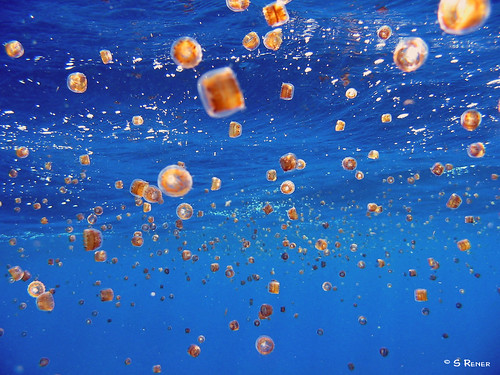 |
| Sea Thimble (Linuche unguiculata) Jellyfish Bloom. Photo Credit: devildiver |
It is easy to characterize global
climate change as a series of disastrous effects that negatively impact every
species on our planet. However, some species are actually benefiting
from rising global temperatures. Several jellyfish populations around the
world are exploding due to, according to many researchers, climate change!
However while one species thrives it can dominate the ecosystem, and cause
negative secondary and tertiary effects in the ecosystem by
lowering biodiversity. The explosion of jellyfish populations, which in turn cause a significant loss of biodiversity, is an example of the immense and unpredictable impacts caused by climate change.
Jellyfish species have a huge effect on global ecosystems because they can be found everywhere and are a central part of every food web. Jellyfish are
members of the phylum Cnidaria. They can be found in every ocean and they span all oceanic environments including the intertidal zone, the open ocean photic zone and
hydrothermal vents. Jellyfish are ecologically significant as a major predator and food source. Jellyfish feed primarily on
zooplankton, comb jellies and other jellyfish. As some species have grown in
numbers and individuals have grown larger in their longer life spans, jellyfish
have also begun to prey on some fish and crustacean species and many roes (fish
eggs). Jellyfish are also preyed upon by larger fish and sea turtles.
 |
| Example food web for Jellyfish species. Photo Credit: SCF Faculty |
The niche
fulfillment of jellyfish, the role they play in an ecosystem, is kept in check by predation and prey availability. Despite
this balance some jellyfish populations have exploded in the last few decades. The
increase in jellyfish leads to a decrease in other organisms and an equilibrium
shift in the food web. Over an extended period of time these
ecosystem effects lead to instability of the food web and lower biodiversity. Such
large populations are also considered economically problematic for humans
because they clog fishing nets, they clog hydro power plant generating systems, and they can
cause injuries to professionals and recreationalists alike (Moeller, 1984).
The rapid increase of jellyfish populations is predominantly attributed one of two causes: over fishing
or climate change.
Several studies have looked at climate change as a possible
cause for jellyfish blooms (Brodeur et al., 2008; Mills, 2001; Hare and Mantua, 2000; Purcell, 2005). Most of these studies are conducted in the North Pacific
Ocean and Bering Sea because these two regions “appear to filter climate variability
strongly, and respond nonlinearly to environmental forcing,” meaning that these areas are strongly affected by climate change and that the affects are exponential (Hare and Mantua, 2000). In this way jellyfish blooms in the Bering Sea are a way to observe and
measure climate change.
Climate change impacts jellyfish populations because more extreme
seasons can lead to increased zooplankton and phytoplankton food sources for
jellyfish which ultimately supports seasonal reproductive blooms of jellyfish
that grow to dominate ecosystems (Mills, 2001). These blooms have the greatest impact when a non-native jellyfish species begins to dominate its new
environment and becomes a successful invasive species.Though blooms are a common feature of jellyfish life cycles, their frequency and size has increased for a few jellyfish species so dramatically that the biomass of the population is dominating the ecosystem. The problem is not that the jellyfish populations are increasing. By becoming a dominant species in an ecosystem jellyfish are outcompeting other species for resources like food and space, forcing some species out of a community, and lowering the community biological diversity. This process is what scientists call a "trophic cascade effects" an effect that we can expect to see from human influences in diverse communities (Folke et al., 2004).
 |
| Many communities where jellyfish are blooming were once fish dominated. When we humans attempt to fish in these locations now we are directly affected by increases in pellyfish populations, falling biodiversity, and the disappearance of species we once relied on. Photo Credit: Eating Jellyfish. |
For a list of jellyfish blooms around the world check out the Monterey Bay Aquarium "Jellywatch"
Not all of
the effects of global climate change may be positive for jellyfish species.
Warmer water temperatures increase metabolism and therefore asexual
reproduction, but some jellyfish species, especially those in arctic waters may
soon find themselves in conditions that exceed their temperature thresholds. In
such cases global climate change can lead to the depletion or elimination of
some previously flourishing jellyfish species (Purcell, 2005). Even for species that are currently thriving due to climate change, the climate may change too quickly for species to evolve. The ability of any species to succeed will be impossible to predict.
Jellyfish are
a model for how human activities are causing far-reaching impacts. Many of the researchers, fishermen, and politicians who find themselves directly affected by recent jellyfish blooms are calling for jellyfish to be hunted and removed from the oceans, but this will not solve the problem. The
exploding populations and subsequent loss of biodiversity are indicative of climate change. Rather than treat the symptoms of biodiversity loss, we must treat the causes, and stop the same patterns of biodiversity loss from recurring and spreading across the planet.
For more information on current research concerning jellyfish and biodiversity:
Works Cited
No comments:
Post a Comment